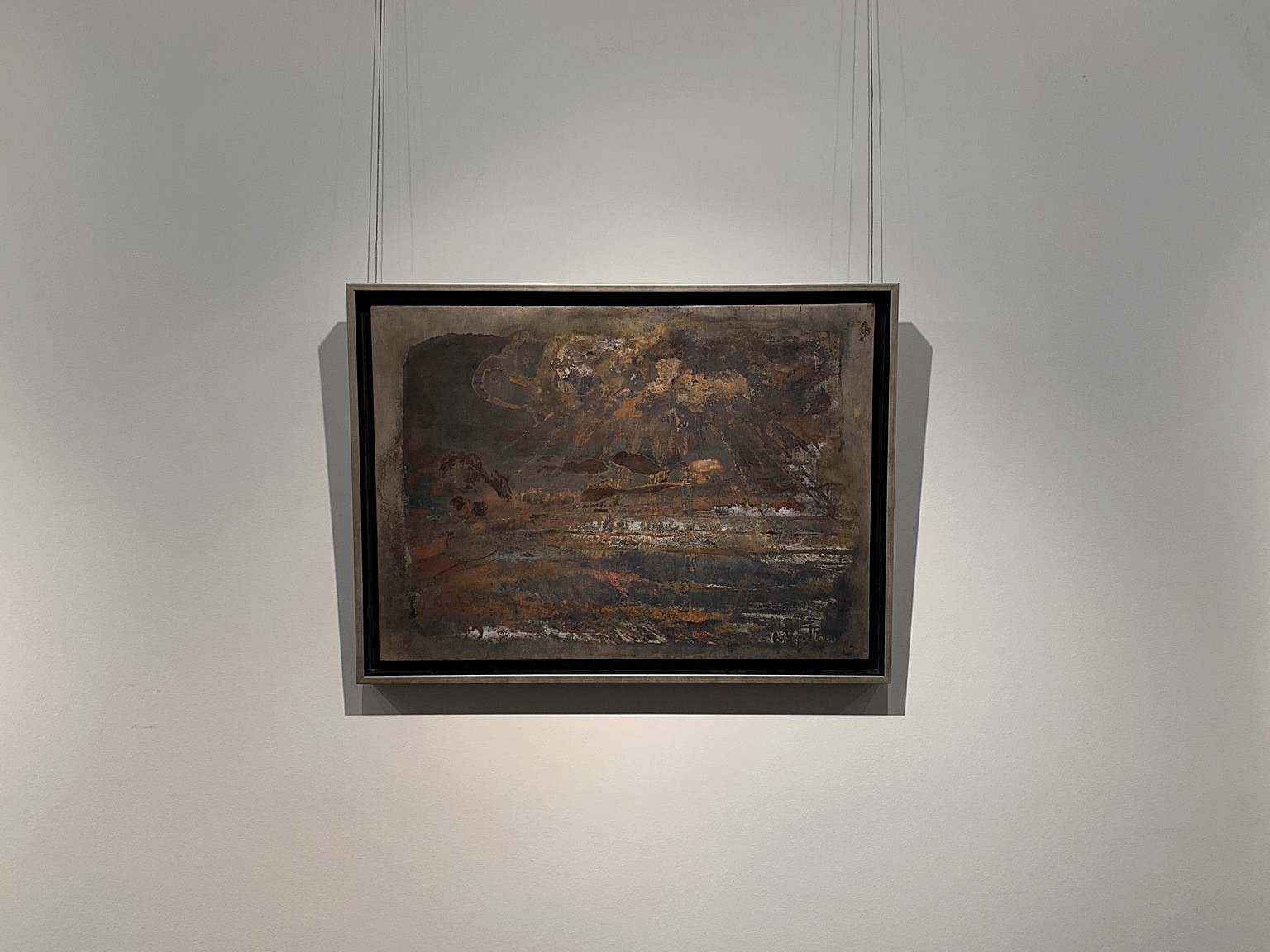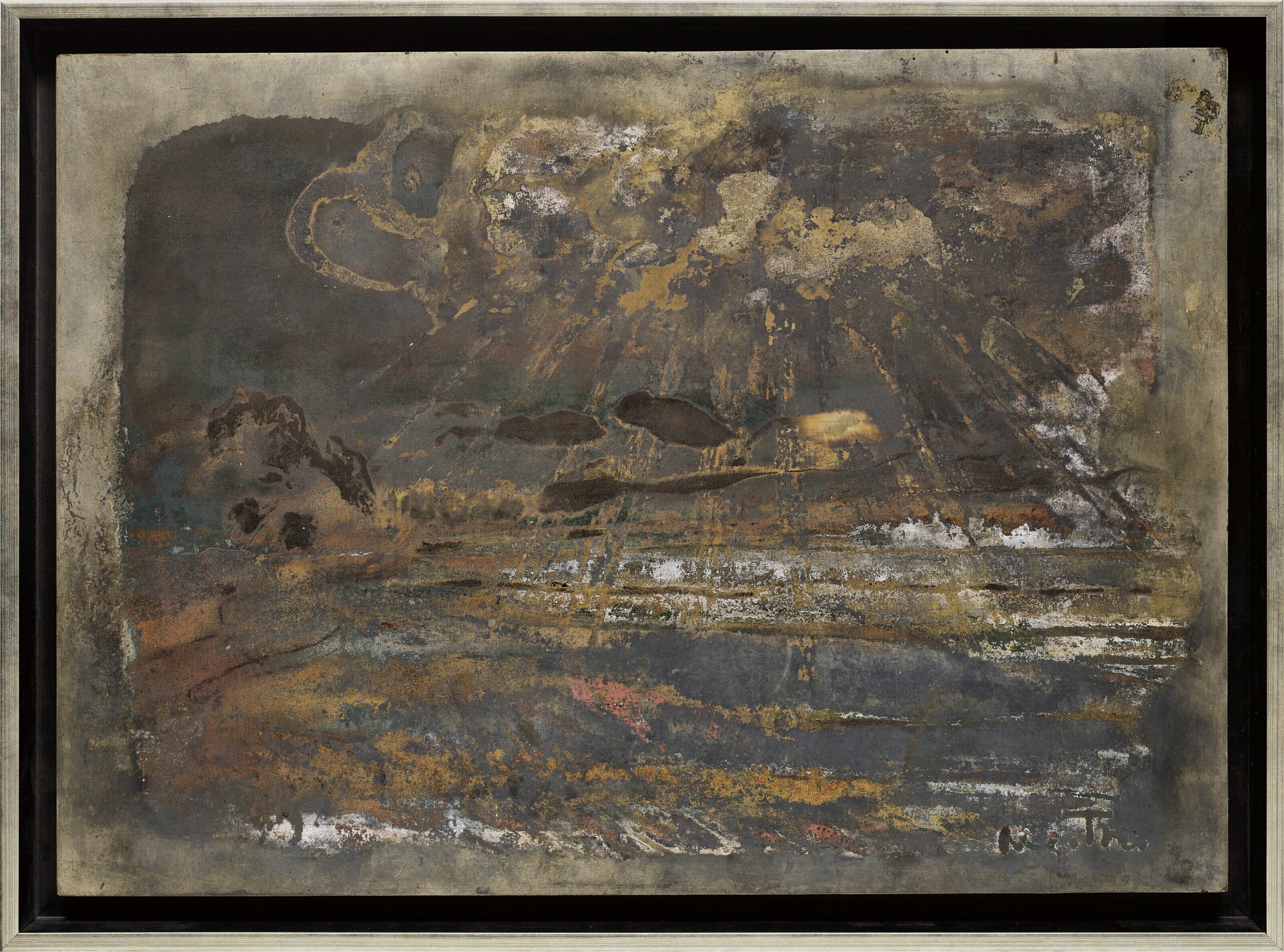

Nguyen Gia Tri (Vietnam, 1908-1993)
Ombres et lumières sur la moyenne région (Shadows and Lights on the Middle Region)
signed and dated 'Ng Tri 70' (lower right)
lacquer on panel
44 × 61 cm. (17 3/8 × 24 in.)
Executed in 1970
Provenance
Private collection, France
Marseille Enchères Provence, Marseille, 14 November 2022, lot 142
Acquired at the above sale by the present owner
Estimate
HKD 150,000-200,000
USD 20,000-26,000
Price Realised HKD 201,600 at Christie's Hong Kong, 24 September 2023
NGUYEN GIA TRI, 1970, "SHADOWS AND LIGHT ON THE MIDDLE REGION" OR "BLANDNESS", SUPREME CLARITY OF THE SOUL
Shadows and Light on the Middle Region is a breathtaking lacquer by Nguyen Gia Tri.
Executed in 1970, this work is the crucial marker of a precise historical context, the brilliant expression of the artist's talent at its peak, the subtle depiction of an indescribable feeling.
It is a milestone in the painter's oeuvre.
An essential witness to a specific historical context
In 1970, settled in Saigon, Nguyen Gia Tri had left his native North–where he was born, more precisely in Hadong in 1908 for almost 2 decades. From an early age, he was an active militant in Việt Nam Quốc Dân Đảng, the revolutionary nationalist party founded on December 25, 1927, and a participant in Tự Lực Văn Đoàn, the social and cultural emancipation movement that began in 1932. He was an artist and as an attentive analyst of the political situation of his time, he was tormented by the gravity of the situation in 1970. The Têt offensive two years earlier had revealed the fragility of the South's situation and the slow erosion of its military capabilities. Exiled to Hong Kong and then forced to leave the North, he realised that he would probably never see the Middle Region of his native Tonkin again. At 62, with a lifetime of artistic and political struggles behind him, he knew that a man could be deprived of everything but his nostalgia.
Nostalgia, ‘longing for the past the way it was’ (André Comte-Sponville), is the theme that structures this lacquer. There is no feeling of regret to be found, because the memory is always present. No gratitude either, because the longing is there. And no hope...
The best lacquerer of his generation, offers us one of his most accomplished compositions, as an ode to nostalgia.
A brilliant expression of the talent of a mature artist
This lacquer painting goes beyond the sometimes over-decorative majesty of the artist's earlier classical works and his monotonous somewhat too mechanical later compositions.
Two choices in particular characterise this work: pale tones and a semi-abstract depiction.
Deliberately pale tones.
Three well-documented works, La Perfection ou Femmes et Jardins du Vietnam painted from 1956 to 1959, Les Élégantes painted in 1968, and Nostalgie du Haut Tonkin executed in 1968, are strong in colour, thus refute the theory of a lack of colour in the South following the 1954 partition. Phu Tho lacquer which had become unobtainable, would have forced Nguyen Gia Tri to use in some compositions these duller tones than usual.
That is simply not true. Very early on, particularly within the Gia Dinh School founded in 1913, the differences between Northern lacquer from Phu Tho and Phnom Penh lacquer from neighbouring Cambodia were identified. For example, the latter dries faster and is easier to apply, with deeper, richer, darker pigments. It is also true that, until then, the border blockade between Vietnam and Cambodia has prevented imports which led to a spike in lacquer prices. In the 1960s, these differences and high prices even led to the development of a lacquer-based paint called ‘artificial paint’, offering all the colours of oil paint, easy to apply and economical, with fast, long-lasting pigments. But none of this concerns our painter.
A semi-abstract description.
In this painting, the artist expresses himself in thin brushstrokes. He forces us to open our eyes and grasp the perspective.
On the periphery, like an atmosphere, the light beige of the sky and the evocation of distant peaks call to mind the High Region.
In the centre lies a massive rectangle dominated by tones of gray, rust and ochre, where blue-green, brown, grey, pink, green and white mingle and intermingle. In brown, lie the more figurative foothills on which a "sugar loaf" is outlined with more peaks in darker red. A house with a golden roof.
Below, rice paddies aligned.
In the middle and above, clouds pierced by the sun's rays. And an atmosphere of impending rain, so typical of the region.
Deliberately soft tones and a dilution-diffusion like a diffraction through the prism of memory.
Memory...
The subtle manifestation of an unspeakable feeling
‘When the various flavours, ceasing to oppose each other, remain in plenitude: the merit of blandness is to give us access to this undifferentiated depth of things,’ writes philosopher François Jullien in his Éloge de la Fadeur (Eloge of Blandness) (Paris, 1991 p.19), translated into Vietnamese (Nhà Xuât Ban, Dà Nang, 2003) and English (Zone Books, New-York, 2004). Nguyen Gia Tri offers us this ‘undifferentiated depth of things’ in the tradition of Ni Zan (1301-1374).
The artist embodies Shitao's (1642-1707) definition of the ideal attitude of the landscape painter: ‘On the limited surface of a painting, he orders Heaven and Earth, mountains, rivers and the infinity of creatures, and all with a detached heart and as if in nothingness. ’ A particular state of consciousness is required. In a subtle dialectic, everything that might refer to freedom, detachment, sobriety and privation must come together. Ni Zan used that ‘pale-insipid’ ink typical of the secret flavours of literary creation. Nguyen Gia Tri uses his pale colours to build an animated void where everything is offered while everything seems hidden.
It is the magic of the language of painting that allows us to formulate what we cannot enunciate. Nguyen Gia Tri, with this sumptuous work, offers us his memory of the North as the essential page not reread but torn from the book of his life.
Like an inner exile.
Nguyen Gia Tri's deliberate blandness expresses the most extreme flavour contained within, that of his lost and transcended land.
A land that will never again be stolen from him.
Blandness, that supreme clarity of the soul.
Jean-François Hubert
Senior Expert, Art of Vietnam










